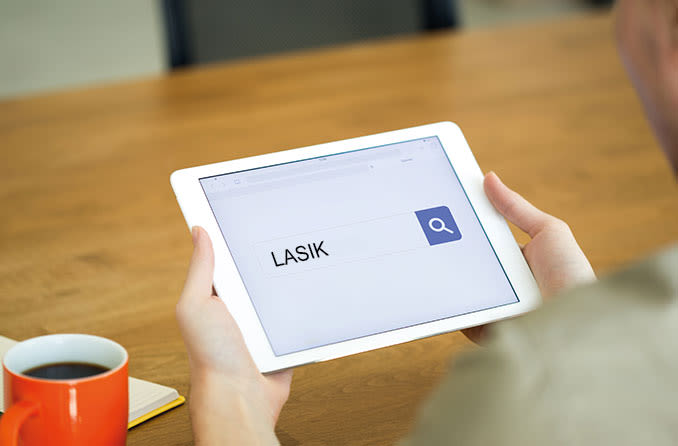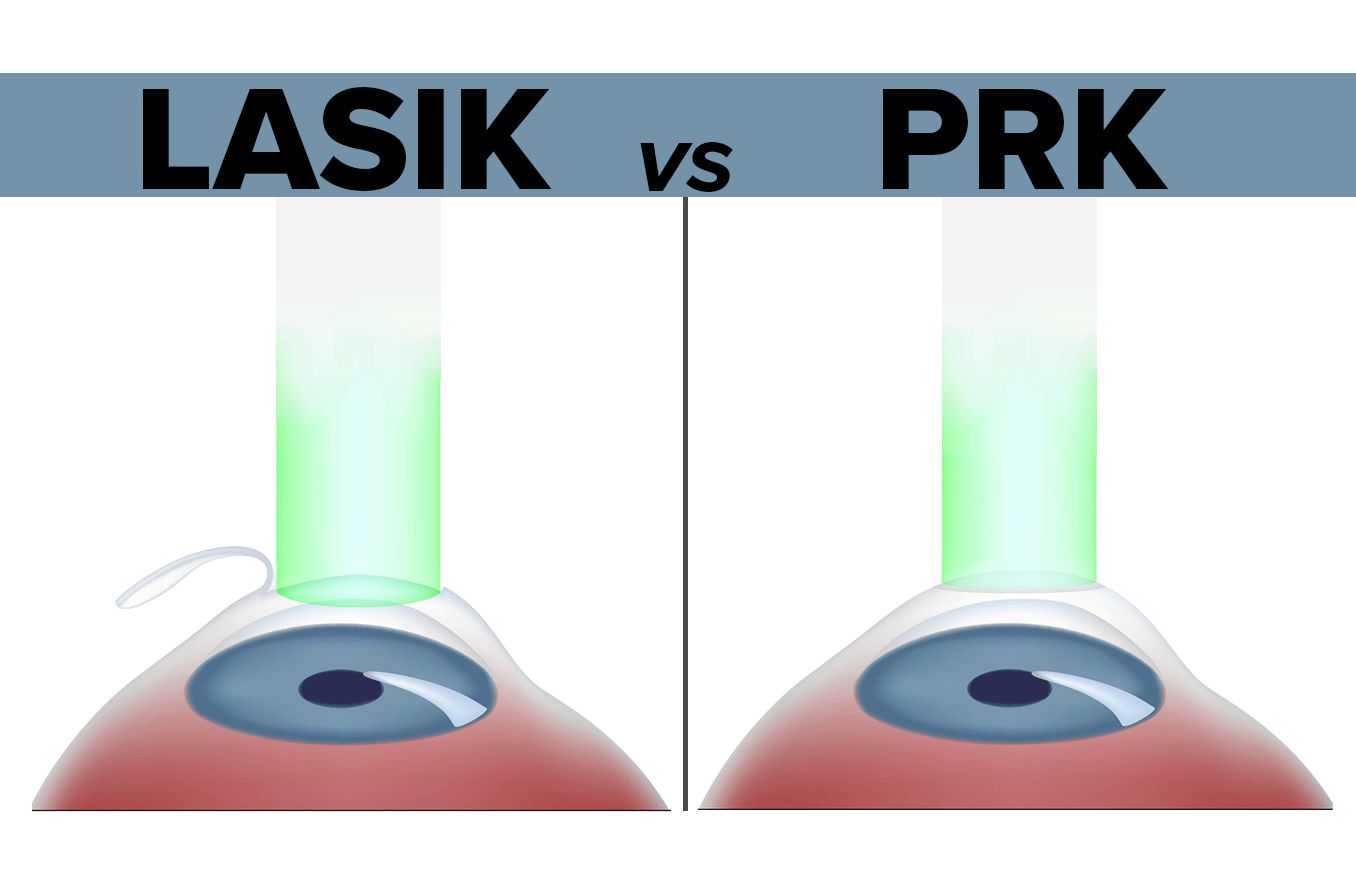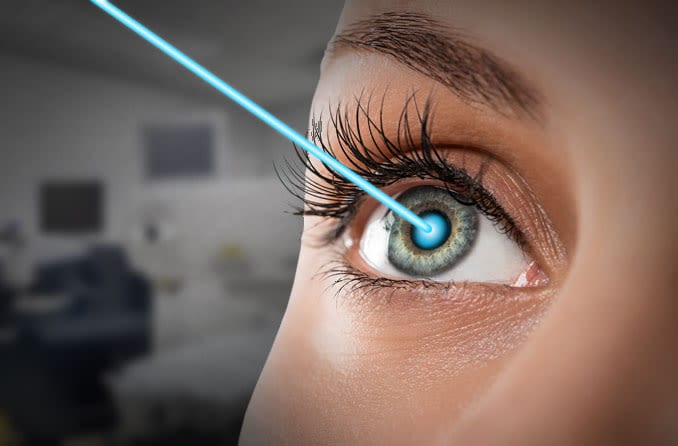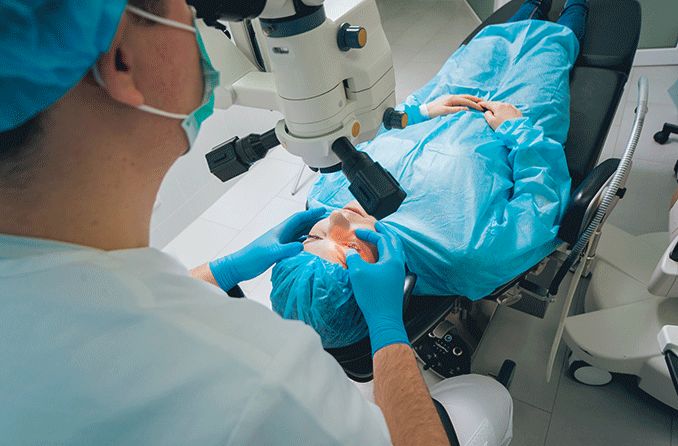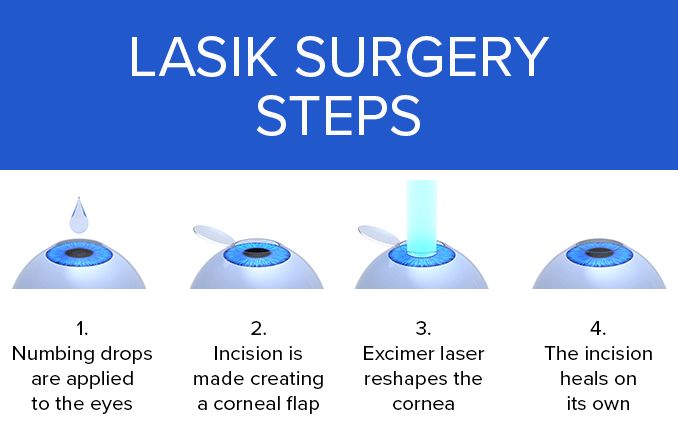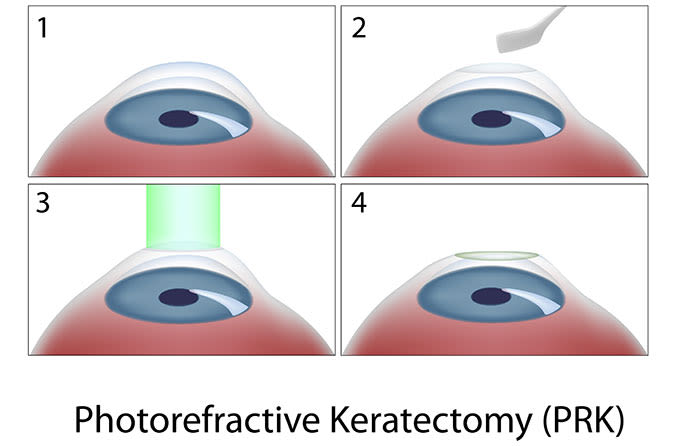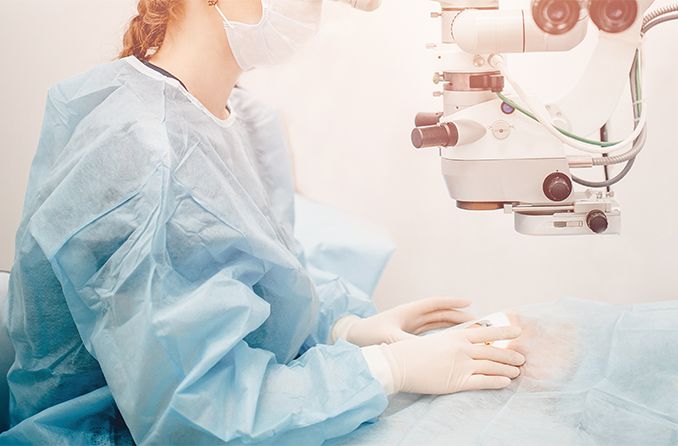LASIK vision correction is one of the most popular elective surgeries in the world, and around 700,000 people in the United States opt for the procedure each year. If you are thinking about having LASIK, you’re probably curious about what happens after surgery. What are the dos and don’ts? How soon will you be able to see clearly? Is there complicated aftercare?
We’ve compiled a list of 20 common after-LASIK questions to get you the information you need.
1. How long is recovery after LASIK?
Most people can see clearly immediately after surgery, and any soreness or redness should be gone in about a week. The cornea does most of its major healing during the first two to four weeks after surgery; however, full recovery takes from three to six months.
It’s common for people to experience some vision fluctuations during this time; but overall, vision continues to improve until the eyes are completely healed.
2. What happens right after LASIK surgery?
After your laser surgeon has completed your LASIK procedure, you’ll have a few minutes to rest with your eyes closed. Then you’ll have a quick eye exam to measure your visual acuity and make sure the corneal flaps are resting in place as they should. Your surgeon or another eye care professional may administer anti-inflammatory or steroid eye drops, and then you’ll be released to recover at home.
3. Can I drive myself home after LASIK surgery?
No, you will need to have a responsible adult drive you home after LASIK. Certain aspects of the procedure can make it unsafe to drive for a few hours.
For example, your eyes will be more sensitive to light than usual. Also, as the numbing eye drops begin to wear off, your eyes may start to water and sting enough to affect your ability to drive safely. Immediately following surgery, your vision can fluctuate quite quickly from clear to blurry, and you don’t want that to happen on the road.
4. Do I need to use eye drops after LASIK?
Yes, it is very important to use all of the eye drops prescribed by your LASIK surgeon as directed. You will be given prescriptions for anti-inflammatory and antibacterial eye drops. You’ll also need to make sure you purchase plenty of your doctor’s recommended over-the-counter artificial tears.
The anti-inflammatory and antibacterial eye drops are generally prescribed for five to seven days, but you’ll need to use the artificial tears for several weeks.
5. Will my eyes be red after LASIK?
You may have red spots in the white part of your eyes following LASIK, but it depends on the exact methods used by your laser surgeon.
The small red spots some people have after LASIK are simply broken blood vessels. They are often caused by the pressure of the suction ring used to hold the eye still during surgery, and they shouldn’t cause you any concern. If you follow your doctor’s instructions for recovery, they should heal in a week or two, about as long as it would take a bruise to heal.
6. Will my eyes hurt after LASIK?
Once the numbing eye drops wear off, you may feel some discomfort for one or two days, but most people are able to tolerate it pretty well. The most common sensations after LASIK are general soreness, stinging and grittiness — as though there is sand in your eyes.
LASIK surgeons usually recommend going right home and taking a nap following surgery. When you wake up, the worst of the discomfort will be over. You can manage any lingering soreness with over-the-counter pain relievers.
7. How long will my vision be blurry after LASIK surgery?
Spells of blurriness happen most often during the first few days following surgery and tend to decrease significantly over the first month. This is a normal part of healing, but it can worsen if your eyes become too dry. It is also common during the first weeks after LASIK to experience vision issues such as light sensitivity, seeing halos and glare, and a decrease in night vision.
8. Can my vision get worse after LASIK?
Yes, vision can get worse after LASIK. For example, LASIK won’t prevent you from developing presbyopia (age-related loss of near vision). And while the changes to your cornea are permanent, if your nearsightedness or farsightedness is still progressing, your vision will eventually become worse. This is why one of the criteria for LASIK candidates is having a stable lens prescription for at least one year before surgery.
People who develop presbyopia after LASIK can wear reading glasses when needed or may be candidates for another surgery called presbyLASIK. Other types of vision regression can be treated with a LASIK enhancement procedure or may not be significant enough to need correction.
9. What happens if I rub my eyes after LASIK?
Rubbing, touching or applying any pressure to your eyes after LASIK can disturb the corneal flaps created during the procedure. Even though the flaps begin healing right away, it doesn’t take much pressure to move them out of place during the first few days after surgery. Keeping your fingers away from your eyes will also help to prevent infections after surgery. If you suspect something is wrong after LASIK, contact your surgeon immediately.
10. Can I take a shower and swim after LASIK?
You should wait at least 24 hours after LASIK surgery to take a shower. Even then, it’s important not to let the force of the water hit your face or let soap or water get in your eyes. You should also avoid washing your eyelids — or drying them with a towel — for at least a week.
You can swim in pools and natural bodies of water after two weeks, but be sure to wear goggles. Chlorine can irritate healing eyes, and non-chlorinated water carries bacteria that can lead to infections.
11. How soon can I wear makeup after LASIK?
Eye makeup, as well as any cosmetics, creams or lotions that could flake or “run” into the eyes, are a bad idea for at least a week after LASIK. Putting on and removing makeup also apply pressure to the eyes, which you want to avoid.
Plus, many cosmetics contain chemicals that can be irritating to your eyes, especially after surgery. Most ophthalmologists recommend throwing out all your pre-LASIK eye makeup to help prevent any bacterial infections.
12. How soon can I exercise after LASIK?
The healing time necessary before exercise varies from patient to patient, as well as for different types of activity. In general, it’s considered safe to begin light exercise after about three days and more strenuous exercise in one to two weeks.
During the first week, you want to avoid sweat dripping into your eyes (and wiping sweat out of your eyes). Sit out of contact sports for at least two weeks and be sure to wear eye protection for two weeks after that.
13. Can I watch TV after LASIK surgery?
Your eyes need as much rest as possible in the first 24 hours after LASIK, so that means skipping all kinds of screen time and even reading in general. We tend to blink much less often while looking at screens and reading. This can lead to dry eyes and eye strain, even in eyes that haven’t just had surgery.
Your eyes will also be extra sensitive to light, so watching TV or using a computer can cause headaches. You can start to add in short periods of screen time over the next week, but make sure to use plenty of artificial tears to keep your eyes lubricated.
14. What helps dry eyes after LASIK?
Most cases of dry eye after LASIK can be managed with over-the-counter lubricating eye drops. It’s important to use these eye drops as often as your eye doctor directs you to, even if your eyes don’t “feel” dry. You should also avoid too much eye strain as you heal.
Dry eye symptoms are very common after LASIK and usually last four to six weeks. However, in some cases, they can last longer or never completely go away. If your symptoms are severe or last longer than expected, your eye doctor may recommend prescription eye drops or other dry eye treatments.
15. What happens if I cry after LASIK?
It’s okay to cry after LASIK. Whether your eyes are watery or you happen to cry for an emotional reason, natural tears won’t harm the corneal flaps or hinder the healing process. Crying can actually help keep your eyes lubricated. The biggest risk related to crying after LASIK is that you might touch your eyes to wipe away the tears.
16. Can I smoke after LASIK?
Most eye doctors urge patients to avoid smoking for at least a few weeks, or until the corneas are fully healed. Both cigarette and marijuana smoke are known eye irritants and causes of dry eye.
Smoking cigarettes can also suppress the immune system, constrict blood vessels and slow down tissue healing. Keeping the eyes moist, comfortable and healthy is critical for healing properly and avoiding complications.
17. Can I wear contacts after LASIK?
In general, it is safe to wear contact lenses around eight to 12 weeks after LASIK, but it’s important to schedule an exam with your eye doctor to make sure your corneas have fully healed first.
If you need or want to wear contacts on a regular basis after LASIK, you might need to be fitted for specialty contact lenses. This is because LASIK changes the shape of your cornea, making it a bit more difficult to wear standard soft contacts.
18. Why do I have to go to follow-up exams after LASIK?
Your eye doctor needs to monitor your healing progress and make sure your vision is improving as expected. Most ophthalmologists will have you come back 24 hours after surgery for the first exam, and this is when you’ll be given the all-clear to drive if your new vision is at least 20/40. Depending on your progress and other factors, you may have a few more follow-ups over the next three to six months. These can be with your LASIK surgeon or your regular eye doctor.
It’s important to note that you still need to have regular comprehensive eye exams after LASIK to maintain your overall eye health.
19. Are headaches normal after LASIK?
Headaches aren’t a common symptom after LASIK for most people who stick to their eye doctors’ aftercare instructions. However, eye strain and light sensitivity can contribute to headaches, so keeping screen time to a minimum and wearing sunglasses outside while you heal is important. Some people may also have headaches after driving or doing other distance-vision activities until their vision stabilizes.
If you have persistent headaches after LASIK, make an appointment with your eye doctor to find the cause and get proper treatment.
20. Is LASIK really connected to depression or suicide?
It is true that several people are known to have ended their own lives after struggling with post- LASIK complications. There are also others dealing with depression they say stems from the same types of complications.
Though the FDA’s most recent research about LASIK outcomes shows that less than 1% of people have long-term problems after the procedure, 1% is not zero. LASIK surgery is one of the safest elective surgeries available, but a good eye doctor will tell you that not all LASIK complications are predictable.
If you are considering LASIK surgery, it’s very important to understand the potential complications and to know the criteria for a good LASIK candidate. It’s also critical to find a highly experienced LASIK surgeon and to disclose any existing problems with depression or dry eye prior to having the procedure.
